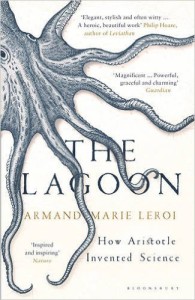Armand Marie Leroi “The Lagoon: How Aristotle Invented Science”
 Award-winning The Lagoon: How Aristotle Invented Science by biologist Armand Marie Leroi ( http://www.armandmarieleroi.com/ ) is an absorbing commentary on Aristotle’s Historia animalium of Enquiries into Animals. Examining the text twenty-three centuries after it was written, Armand Marie Leroi discovers many similarities in the way the two scientists approach their discipline, dissections and even in their methodologies. Of course there are many variations too. Yet this is a fascinating book. To be dipped into. To savour. To understand. To experience. To share.
Award-winning The Lagoon: How Aristotle Invented Science by biologist Armand Marie Leroi ( http://www.armandmarieleroi.com/ ) is an absorbing commentary on Aristotle’s Historia animalium of Enquiries into Animals. Examining the text twenty-three centuries after it was written, Armand Marie Leroi discovers many similarities in the way the two scientists approach their discipline, dissections and even in their methodologies. Of course there are many variations too. Yet this is a fascinating book. To be dipped into. To savour. To understand. To experience. To share.
This book is an exploration of the source: the beautiful scientific works that Aristotle wrote, and taught, at the Lyceum. Beautiful, but enigmatic too, for the very terms of his thought are so remote from us that they are hard to understand. He requires translation: not merely in English, but into the language of modern science. That, of course, is a perilous enterprise: the risk of mistranslating him, of attributing to him ideas that they could not possibly have had, is always there.
The perils are particularly great when the translator is a scientist. As a breed we make poor historians. We frankly lack the historical temper, the Rankean imperative to understand the past in its own right. Preoccupied with our own theories, we are inclined to see them in whatever we read. …obvious to any scientist, if not to all historians, that science is cumulative, that we do have predecessors and that we should like to know who they were and what they knew.” ( p.9)
The Lagoon is profusely illustrated with line drawings. It is amazing to read about the number of animals Aristotle was familiar with. Apparently his student, Alexander the Great, collected and acquired biological specimens whenever he went abroad for his teacher. So Aristotle’s knowledge and understanding of flora and fauna was not confined to those found around the Aegean Sea but far beyond. For instance he was even familiar with an Indian Rhinoceros, hippopotamus and mongoose, biological specimens that are not found locally in Greece.
This book is so elegantly written. It can be read from any point and enjoyed immensely. Reading it from cover-to-cover may become a tad tedious for a layperson but the beauty lies in the ability of Armand Marie Leroi making the science readable. It is packed with information, details and innumerable tiny connections between the past to the present — an admirable feat given that there are a mere twenty-three centuries separating the two scientists.
Given how many giant strides digital publishing has taken in recent years, it would not be a bad idea to have this book converted into an interactive edition for an ereader with tiny movies, snippets of documentaries and 3D images embedded in the text. Maybe something like this full-length interactive book for the iPad that software developer Mike Matas demonstrated at a TED Talk some years ago, March 2011. https://www.ted.com/talks/mike_matas?language=en
The Lagoon is a keeper. A must for personal and institutional collections. I would be delighted if this text could be converted into a Michael Wood-like documentary series for television and the Internet.
Armand Marie Leroi The Lagoon: How Aristotle Invented Science Bloomsbury, London, 2015. Pb. pp.500 Rs499
( with translations from the Greek by Simon MacPherson and original illustrations by David Koutsogiannopoulos )


